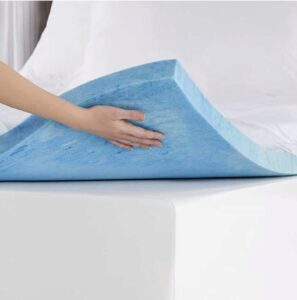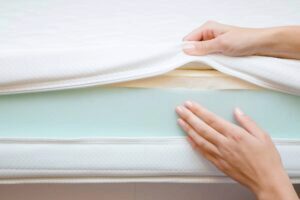Is Memory Foam Safe?
Disclosure: By clicking on the product links in this article, Mattress Nerd may receive a commission fee at no cost to you, the reader. Read full disclosure statement.
If you’re shopping for a new mattress, then you have to choose from one of several materials, including innerspring, latex, or memory foam. Due to its pressure relieving properties and soft composition, memory foam is certainly in the running for the most popular of these materials. But is it safe?
Over the years, manufacturers have modified their processes to ensure that their memory foam products are safe for the environment and consumers. While memory foam mattresses are certainly safe, it’s still important for you to understand how they’re made, and what steps are being taken to protect you. Read on to learn more.
What Is Memory Foam?
The first question to answer is: What is memory foam? Memory foam is a unique synthetic material that is made out of a polymer known as viscoelastic polyurethane. This dense and durable material is used in all kinds of furniture, from mattresses and mattress toppers, to sofas and car seats. It’s become so popular because it can retain its shape and structural integrity for a very long time and it delivers fantastic support.
There are three primary types of memory foam, each with their own level of support and unique benefits.
Traditional
Traditional memory foam is the most common type of foam found in furniture. It molds perfectly to your body, providing a personalized sleep experience that you won’t get from an innerspring mattress. The one flaw of traditional memory foam is that it can potentially trap heat, leading to you feeling hot at night. Fortunately, the other types of memory foam can resolve this issue.
Gel
Gel memory foam is pumped full of two different types of gel. The first gel is able to absorb or repel heat, allowing you to stay nice and cool at night. The second type of gel is a phase-changing material that further absorbs heat and pushes it away from your body, ensuring you don’t become trapped in your own body heat at night.
Open Cell
Open cell memory foam has a special internal structure that consists of numerous open holes. This open-cell design enables air to travel more efficiently throughout the mattress, thus preventing heat from building up.
How Is Memory Foam Made?
Different mattress manufacturers may employ various methods for constructing their memory foam mattresses in order to deliver a pleasant sleep experience. However, the general process of manufacturing polyurethane foam consists of adding different compounds and additives to the polyurethane. These chemicals can have a significant impact on the foam’s elasticity and viscosity (its ability to change shape under pressure or to transfer motion).
Is Memory Foam Toxic?
Although most current memory foam mattress models are designed to be as safe and harm-free as possible, there may still be traces of potentially toxic chemicals, blowing agents, carcinogens, and flame retardants in older models, including:
- Benzene
- Naphthalene
- Formaldehyde
- Diisocyanates
- Methylene chloride
- Isocyanates
- Polybrominated diphenyl ethers (PBDEs)
- Chlorofluorocarbons (CFCs)
- Methyl benzene
- Chlorinated Tris (TDCPP)
- Toluene
- Phthalates
- Rayon
- Acetone
These compounds, also known as Volatile Organic Compounds (VOCs), can cause respiratory problems, irritation to your eyes, nose, throat, or skin, nervous system problems, and several other health issues.
In the past, the amount of VOCs and harmful chemical flame retardants in memory foam were high enough to cause potential health problems. However, the amount of these compounds, fire retardants, and chemicals in modern mattresses are so low that they are generally considered to pose no significant health risks. At the same time, current memory foam mattresses still have a low level of flammability thanks to the use of safer flame retardants, such as silica.
Most new memory foam mattresses emit a chemical off-gassing smell when they’re first unpacked. These emissions are completely normal and aren’t a cause for major concern. In order to combat these odors, it’s recommended that you allow it to air out in an empty room with the windows open for several hours.
The Bottom Line
Most manufacturers follow a strict set of manufacturing processes and testing to make memory foam mattresses safe. In addition to this, various agencies like the EPA have put programs into place to ensure compliance with safer processes, so you should be able to avoid any potential health issues or side effects.
Ultimately, you want to find the best mattress for yourself, which means doing your research and carefully analyzing every aspect of the product, especially safety.


